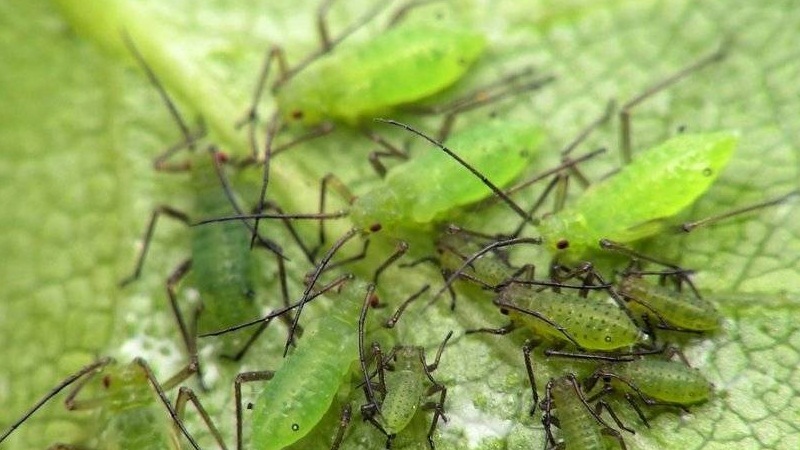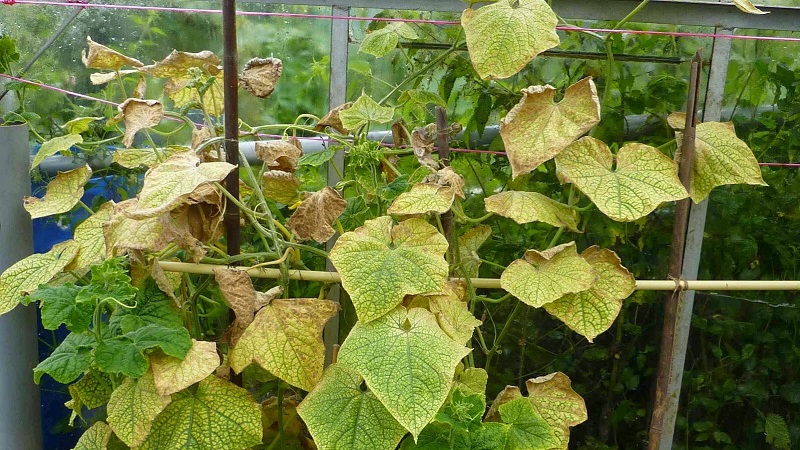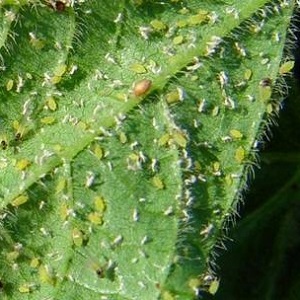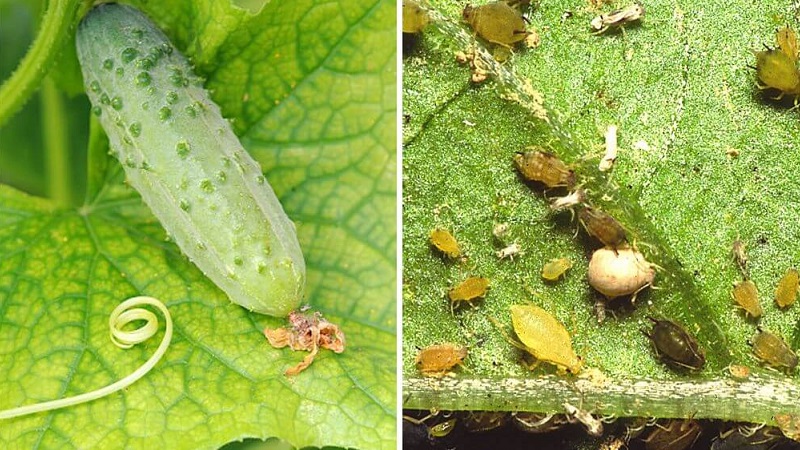How to deal with melon aphids on cucumbers as quickly and efficiently as possible
Cucumber is an unpretentious crop with uncomplicated farming techniques and minimal maintenance. However, various pests are not averse to eating cucumbers. One of the most dangerous and voracious is the melon aphid. The parasite multiplies rapidly and destroys plants and crops.
From the article you will learn everything about the melon aphid and measures to combat this pest.
The content of the article
What is this pest
The melon, or cotton, aphid belongs to the class of insects, the Real aphids family.
This aphid species affects more than 330 plant species: cucumbers, watermelons and melons, pumpkin, cotton, tobacco and others.
In weather conditions, the middle lane becomes more active in the first half of July. In greenhouses, cucumbers can be attacked by pests as early as mid-May.
The parasite is widespread everywhere.
What does it look like
The size of the insect is 3-4 mm. The body of the melon aphid is elongated, pointed towards the back tip. The body is colored in different shades of green, the legs and antennae are dark brown or black. There are winged and wingless individuals.
The sucking mouth apparatus is equipped with a proboscis, with the help of which the insect pierces the tissues of the plant and sucks out the cell sap.
Our photos will help to identify the pest.

How does it multiply
In the spring, the larvae give rise to the colony. They hatch from eggs laid on weeds in autumn at an air temperature of + 5 ° C. The larvae are able to overwinter under the leaves of winter-green plants, for example, in greenhouses.
After molting, the larvae turn into wingless females and begin asexual reproduction.
When the colony is compacted, winged individuals appear, which fly over and are carried by the wind to neighboring plants, where they form new colonies.
During the summer, tens of generations of females are born, the offspring from one larva reaches tens of thousands of individuals.
In autumn, winged males appear and fertilize females, which again lay eggs. It is this offspring that is able to survive the winter and begin the next life cycle.
How to recognize the defeat of cucumbers with melon aphids
On cucumbers affected by aphids, the leaves droop, curl, and fade. Flowers and ovaries fall off.

On the back of the leaves, small insects and a shiny thin film of the sugary waste products of aphids are visible. As the colony grows, insects settle on stems, buds and young shoots.
Harm done
Parasites pierce cucumber leaves with a proboscis and feed on their juice. The leaf plate wrinkles and dries out. The processes of photosynthesis and the formation of nutrients are inhibited. Fruit growth and formation are slowed down.
With uncontrolled reproduction, an aphid colony can lead to the death of the plant and a complete loss of yield.
In addition, aphids carry viral diseases, so the invasion of the pest is often accompanied by outbreaks of the cucumber mosaic.
Reasons for the appearance
High temperatures and humidity are favorable for aphids.
The pest actively multiplies and spreads if:
- there are few natural enemies on the site - ladybirds and their larvae, lacewings, sand wasps;
- there are a large number of ants in the beds, which carry aphids onto plants and protect them from predators.
How to fight
It is not difficult to destroy aphids, the insect is susceptible to the action of various drugs.
There are two rules for a successful fight:
- Simultaneously with the destruction of the parasite, take measures to eliminate the ants.
- Processing by any means should be carried out not only from the top, but also from the bottom side of the sheet.
Chemicals
Insecticides have a powerful effect against aphids:
- "Metaphos" - contact drug. The active ingredient is parathion-methyl. Available in the form of an emulsion in 5 ml ampoules. To prepare the working solution, the contents of 2 ampoules (10 ml) are diluted in 10 liters of water. Processing is carried out in the early morning or evening. The last spraying is not earlier than 30 days before harvesting.
- "Decis Lux" - emulsion of contact-intestinal poison based on deltamethrin. Packaged in ampoules or bottles of various sizes. For processing cucumbers, 5 ml of the drug is dissolved in 20 l of water. Cucumbers are sprayed when the first individuals appear, and when they reappear, after 2 weeks. The waiting period before harvest is 20 days.
- "Inta-Vir" - chemical of contact-intestinal action. The main substance is cypermethrin. It is produced in the form of tablets weighing 8 g. To combat aphids, dilute 1 tablet in 10 liters of water. Processed during the growing season at least 20 days before picking cucumbers.
Important! Work with chemicals in closed clothing, headwear, gloves and a respirator. After work, be sure to wash your hands and face with soap, wash clothes.
Biologicals
Biological products are less toxic to humans and beneficial insects. They have a delayed effect, the death of parasites occurs in 1-3 days after treatment.
Among such means, among vegetable growers, Fitoverm and Aktofit are popular, which have a nerve effect on pests.
| A drug | Active substance | Preparation of working solution | Multiplicity of treatments | Consumption rate | Waiting period |
| Fitoverm | 5% aqueous emulsion of aversectin C | 2 ml for 1 liter of water | 1-2 with an interval of 2-3 weeks | 100 ml per 1m² | 1-3 days |
| "Aktofit" | 0.2% alcohol solution of aversectin C | 8 ml for 1 liter of water | 1-2 with an interval of 2-3 weeks | Until the sheet is completely wetted. When dripping liquid droplets, transfer the stream to another surface to be treated. | 2 days |
Reference. The rates of preparation and consumption of solutions are given for the fight against aphids on cucumbers. When using drugs on other crops or against other pests, you should carefully read the instructions.
Folk remedies
 Budget folk remedies against melon aphids on cucumbers are good as a preventive measure and at the initial stages of infection.
Budget folk remedies against melon aphids on cucumbers are good as a preventive measure and at the initial stages of infection.
The most common recipes are:
- Makhorka or tobacco... 300 g of dry makhorka (tobacco) pour 10 liters of water, leave for 2 days, strain before use and add 70 g of grated tar soap.
- Vinegar. 7 tbsp. l. Dissolve 9% vinegar in a bucket of water.
- Bitter pepper... Grind 50 g of pods of red hot pepper, pour a liter of boiling water and leave for 2 hours, strain and dilute with 10 liters of water.
- Celandine. Pour 200-300 g of dry grass with a bucket of water and leave for a day, strain before use.
- Garlic... Chop 500 g of garlic, add 3 liters of water and leave in a dark place for 5 days. To prepare the working solution, take 50 ml of infusion per 10 liters of water.
- Ash and laundry soap. 50 g of wood ash and 70 g of grated laundry soap are mixed with 10 liters of water.
Vegetables are sprayed with one of the listed agents until the pest disappears completely with an interval of 7 days. The optimal consumption is 1 liter per 10 m2.
Plants that repel the pest
To create a natural barrier against aphids, fragrant plants are planted next to cucumber beds: garlic, marigolds, cilantro, fennel, basil, thyme, peppermint.
Preventive measures
The risk of aphids is significantly reduced with proper vegetable care, so it is important to follow the watering and feeding regime.
The following activities have a preventive effect:
- Control of the ant population. To combat ants, the preparations "Absolute", "Anteater", "Thunder-2" and others are used.
- Disinfection with bleach (400 g per 10 l of water) of the soil and greenhouse structures before planting vegetables.
- Thorough cleaning of all plant residues from the beds. Aphid larvae can survive on weeds and tops.
- Compliance with planting schemes: no more than 4 cucumber bushes are planted per 1 m2. The thickening contributes to the rapid spread of pests.
- Regular plant inspection. A weekly leaf inspection allows you to detect pests earlier and start fighting in a timely manner.

Tips & Tricks
Experienced vegetable growers recommend planting varieties and hybrids with complex disease resistance. They have a strong root system, powerful vegetation and recover faster after pest attacks. It is worth paying attention to the hybrids Goosebump F1, Thumb Boy F1, Masha F1, Pasadena F1.
To combat the parasite, it is useful to attract birds and insects that eat aphids to the site. To lure sparrows, tits, linnet, feeders are hung on the garden plot.
Disembarkation dill and mustard next to cucumber beds will attract ladybirds - natural enemies of aphids.
Conclusion
Aphids are small voracious insects that attack cucumbers and other crops. Feeding on plant juices, the pest destroys plantings and crops. To combat aphids, insecticides and biological products are used. With a slight defeat, folk remedies are also effective.
Attracting birds and insects that feed on aphids to the site helps to reduce the number and gradually destroy the parasite colonies. The main carrier is ants, which gladly eat the sweet secretions of aphids. Therefore, the main preventive measure is to control the number of ants on the site. Regular inspections of the leaves of the vegetable help to identify the problem in a timely manner and take measures to save the crop.